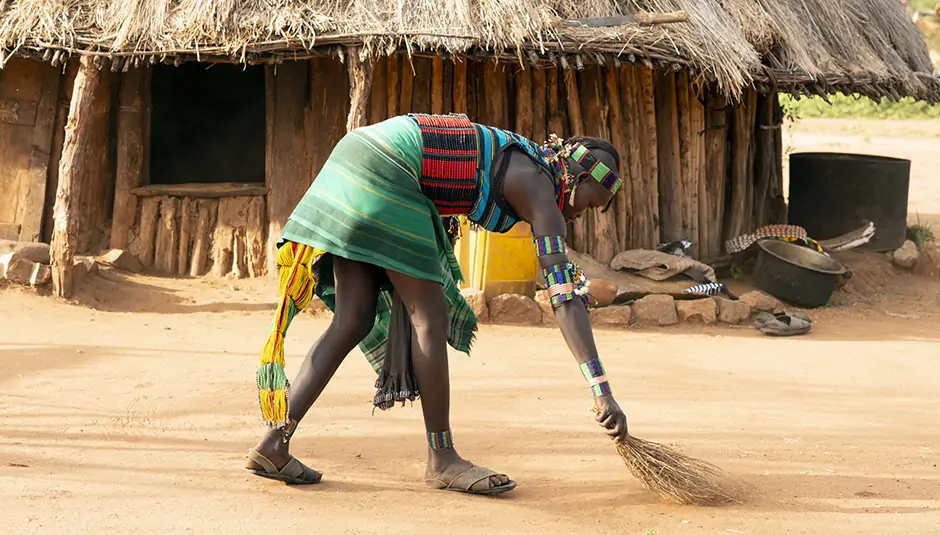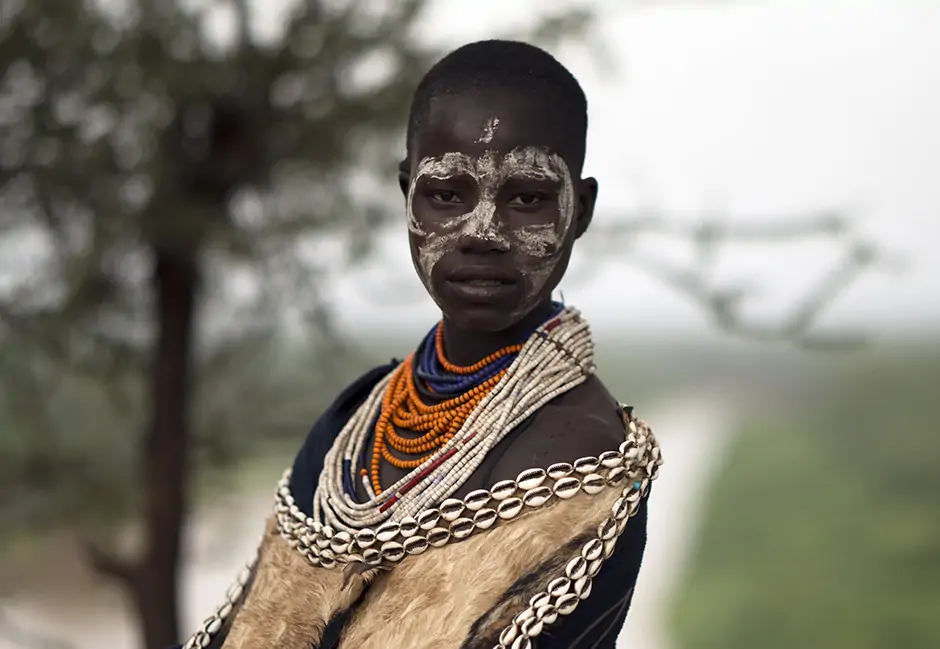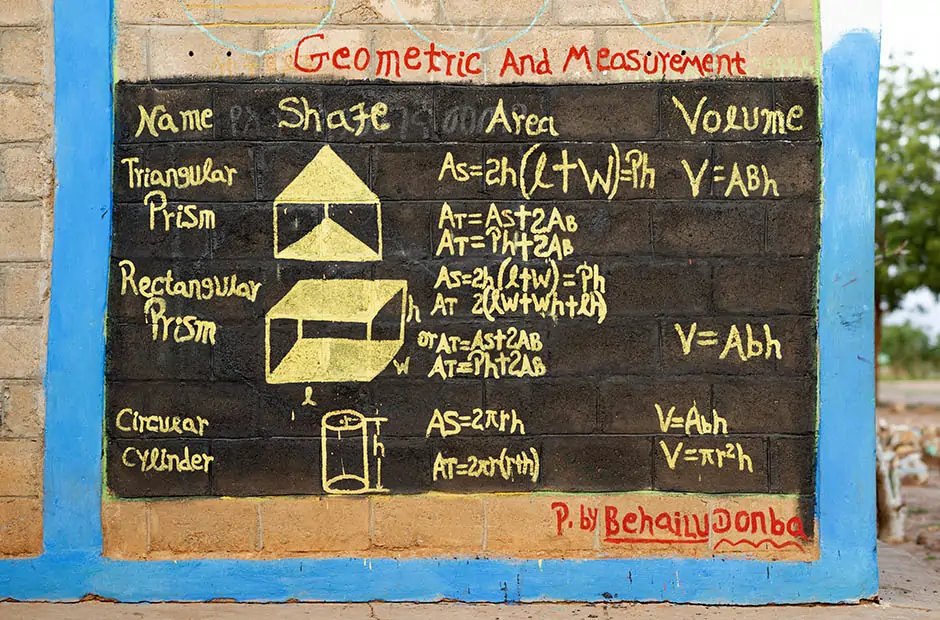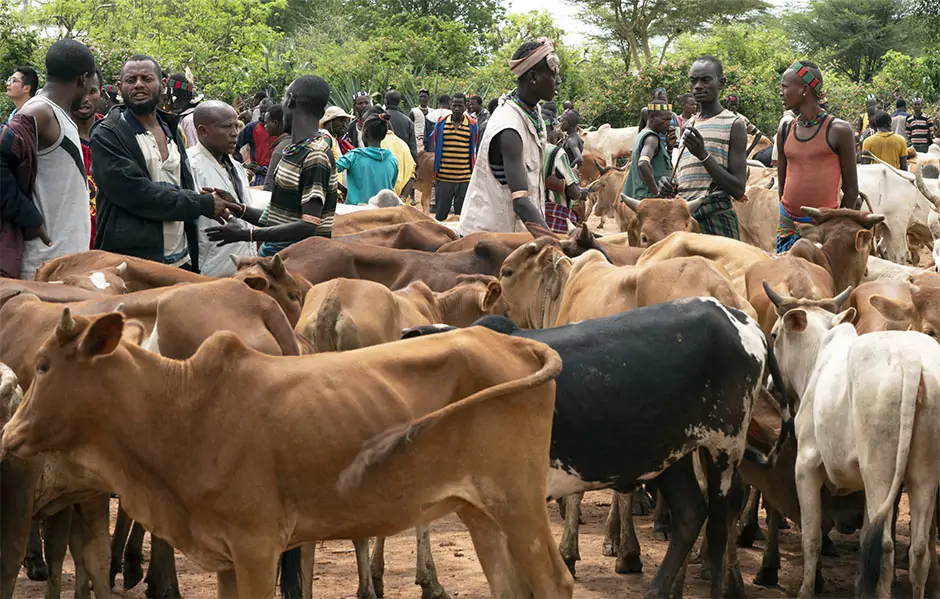East Africa Travel Narrative Story: Loss of Indigenous Knowledge in the Omo Valley, Ethiopia
Story and photography by Ray Waddington.
Click/tap an image to begin a captioned slideshow (best viewed on a modern, wide-gamut display) and stock licensing details.
Outside of cities and large towns, Ethiopia is a very undeveloped country. This is especially true in the region in the south west known as the Lower (or South) Omo Valley. This rural region is home to many different indigenous, ethnolinguistic minority groups, and that is the main reason why tourists visit the area. A word of prior warning is in order though: independent travel to the region is not for the faint-hearted. Public transport will only bring you to small, regional towns — if it is available, which it often isn't outside market days. If you don't speak Amharic, communication will be difficult. Without a local guide it will be difficult or impossible to enter some of the tribal villages and local marketplaces.
Even armed with this knowledge, my original intention was to attempt just that — independent travel. I'd read a few articles written by Western travelers claiming they had done it. I'd spoken to a handful of travel agents in Addis Ababa. The prices asked seemed exorbitant both for a solo traveler and even if I'd been able to join a group. (All the travel agents had said they had no groups scheduled during my timeframe for me to join.) So I booked a return flight to Arba Minch and crossed my fingers.
There, I had even less luck. I made my way from the airport to a central, low-budget but clean hotel. As I ate dinner I was approached, unsolicited, by at least a dozen locals, all of whom claimed to be guides, all of whom were offering higher prices than their Addis Ababa counterparts and all of whom stated that independent travel in the region was literally impossible. One even claimed to be an 'official' government guide and, as such, the only one who could sell me (for a few hundred US dollars) the photography permit I would need to avoid being arrested should I use my camera. (I knew that to be scam.)
The next morning I walked to the bus station intending to try my luck in Konso (also known as Karat). It is the gateway town to South Omo and there lay my best chance to assess just how realistic independent travel was going to be. On entering the bus station I was mobbed. Not by criminals hoping to rob me — Ethiopia is a pretty safe country for violent crime against foreigners — but by locals fighting each other to help me in return for a tip. I'd experienced this in other parts of the world so I was able to take it in my stride and eventually break free.
Most things in Ethiopia do not have a set price in the informal economy. Even though the bus to Konso was government-run, and therefore officially does have a set price, drivers will charge what they think they can extort from both locals and, especially, foreigners. (I found out later that special transport police randomly board buses to investigate whether any passenger has been overcharged.) I located a bus going to Konso but was quoted a price many times higher than it should have been along with a 'subsidy' for my backpack.
I don't object to haggling when I travel, but not when the starting price is so unreasonable. So I walked away not yet realizing the driver had actually done me a favor. Now looking for a private minibus to Konso, I chanced across one taking four Western tourists there. It was faster and the price lower than the public bus so I got in. They all spoke English. Over the next two hours I learned that the driver was also their guide for a one-week tour of the tribal villages in South Omo. I shared my plans with him. He advised me against independent travel while citing multiple, practical reasons. By the time we reached Konso I had decided to join the group for the tour!
No sooner had we checked into a cheap hotel than the tour started. Konso is surrounded by a dozen or so villages inhabited by the indigenous people of the same name. Collectively these villages are known as the Konso Cultural Landscape, which is a UNESCO World Heritage Center.
The villages (paletas) are terraced on hillsides. At first glance this may appear to be simply the obvious solution to population growth within such hilly terrain. But it is much more than that. The region is arid, and seasonal rainfall fluctuates widely. Without a sustained supply of water, no community can survive for long. But the Konso people have survived here for centuries.
The layout of these villages is one example of their remarkable ability to manage and adapt to local conditions using indigenous (traditional) knowledge. Indeed it is this ability that earned them World Heritage recognition. The Konso water supply is augmented by building ponds (harda) to capture and store excess runoff water during times of high rainfall. They would be useless if allowed to fill up with eroded debris. The hillside construction and plantation are actually one of the locally engineered solutions to maintaining the reliability of the ponds. They stem such erosion.
Each new generation inherits political leadership of its village for, at most, eighteen years. A key leadership role is guardianship of the harda. Guardianship is in stark contrast to ownership. The Konso believe that ownership of resources like water is communal. This critical social norm serves to embed a sense of future expectation in the upcoming generation.
During their incumbency, the guardians are expected to perform any required maintenance of the harda as well as to ensure that access to water is equitable. To help them in this role, the Konso have incorporated the religious myth of the water spirit. This spirit is appeased by good social behavior (i.e., respecting the sanctity of the water) and offended by bad social behavior, which is punished by social ostracization.
Due to their practice of erecting olahita, the Konso are sometimes referred to as one of the last megalithic societies. That term implies, at the least, lack of sophistication. Around the beginning of this century the Ethiopian government launched a water harvesting program that, in the case of the Konso, attempted to replace traditional knowledge with a Western, scientific approach and thereby improve agricultural yield. The program was halted after just two years when two-thirds of the government-installed ponds became ineffective. The traditional harda, however, continued to work effectively.
Early the next morning we departed toward Turmi. The plan was to stop in a couple of Hamar villages along the way. Only a few years ago this could have been dangerous. The Hamar people have a (deserved) reputation as fierce warriors who can be very hostile toward outsiders. Our driver/guide knew most of the people in the second village and, unexpectedly, we were invited to spend the night there. This was a great honor for us. Spending a night in such villages is rare even with more expensive organized tours. Our accommodation was the ground in front of a small, traditional tribal hut. We paid more than a basic hotel in Turmi would have cost, but it was much better value for money given the rarity of the cultural experience.
The Hamar are among the most visited ethnic groups in the area. This is primarily because of their unique coming-of-age rite of passage, the bullah. In this ritual ceremony a young man must run several times back and forth over the backs of a small group of cattle without falling to the ground. Failure is a huge social taboo. In a bizarre twist, Hamar women are severely beaten by men at these ceremonies. The Hamar sometimes stage small-scale bullah, lasting up to an hour, for tourists, but attending an authentic one, which lasts a few days, as an outside visitor is very rare.
For our dinner that night a goat was slaughtered. Eating goat is common in this part of the world, but for the Hamar it has special significance. Ethiopia is rich in diversity of indigenous culture. That culture has evolved over tens of thousands of years. It is not surprising, therefore, that indigenous knowledge systems abound.
Indigenous (traditional) medicine — still scarcely studied scientifically — in particular is relied upon by the vast majority of rural Ethiopians. Like most indigenous knowledge systems, those of the Hamar incorporate a holistic world view. Central to this view is barjo älá. It is a life force that permeates and controls everything in the world. Bad barjo älá is believed to cause everything from drought and crop failure to disease. So when someone has a fever, an elder might inspect a goat to determine which ancestor is displeased and causing the bad barjo älá. Ceremony may be performed in place of, or in conjunction with, the application of plant-based medicine to appease the ancestor and bring barjo älá back into balance. Similarly, a Hamar woman might place her young infant inside a dead goat's stomach to breath for a short time, believing this protects her offspring from malaria.
We completed the short journey to Turmi the next morning after a walk around the village. We checked into another basic hotel and this (Sunday) was a free day without any guided activities. Unfortunately, there was a heavy downpour of rain and I did very little that day. But we were due to spend a second night there anyway.
We left early on Monday morning to visit a Karo village. Although it was only a few dozen kilometers away, the road was one of the worst I've ever traveled; it took two hours to get there.
The Karo people are visited by tourists mainly because of their elaborate, artistic body and face painting. They live along the East Bank of the Omo River. That river used to flood seasonally with the rains. Just like the Konso people, the Karo had adapted to this local condition. They (and other ethnic groups in the area) historically practiced highly-productive flood retreat cultivation. Sorghum, maize (corn), peas and beans were grown on sculpted terraces in the fertile, nutrient-rich silt beds left by the river as it receded after each rainy season.
Those days are gone. 2015 was the last year the river flooded. That was the year when Ethiopia's massive Gibe III dam project was completed for a hydroelectric power station. Although they live hundreds of kilometers downstream from the dam, the lives of indigenous peoples like the Karo would change forever.
Now these people had to reinvent themselves to live in a world about which they had almost no knowledge. The most predictable impact was food insecurity. In addition to the dam, the government had plans to divert the flow of the Omo River to provide irrigation for vast, industrial-scale plantations in the area. I'd expressed interest in going to see one of these — a sugar plantation and factory near the small town of Kangaten. The guide assured me that I would not be allowed anywhere near, especially with a camera. The government had been distributing irrigation pumps in the region, but these were of poor quality, often broke and could not support even subsistence agriculture. Instead, government food aid became the subsistence, although it was often used to ferment alcohol instead now that the people had little labor to keep them occupied.
Besides alcohol, the other thing from the outside world that was already familiar to the Karo was tourism. In the space of only an hour in the village I saw how the Karo were reinventing themselves. A mid-morning downpour forced us to shelter inside a village hut when we first arrived. There, a group of young men were already drunk. Once the rain stopped we headed further into the village where dozens of children and adults were waiting, freshly painted, for our cameras and our birr (the local currency). They literally fought each other to win the small amount of money they'd be paid for each photo taken.
By lunchtime we were in the small town of Omorate (also known as Kelem) near the Kenyan border. It is the gateway to indigenous Daasanach villages, one of which was on our itinerary. But I'd had such a negative experience that morning that I opted out of this and all future villages on the itinerary.
We returned to Turmi too late to catch the Monday market. But late that afternoon I walked around the tiny town. Despite its size, Turmi is an important transportation crossroads. In fact it is just about impossible to travel in the region without passing through it.
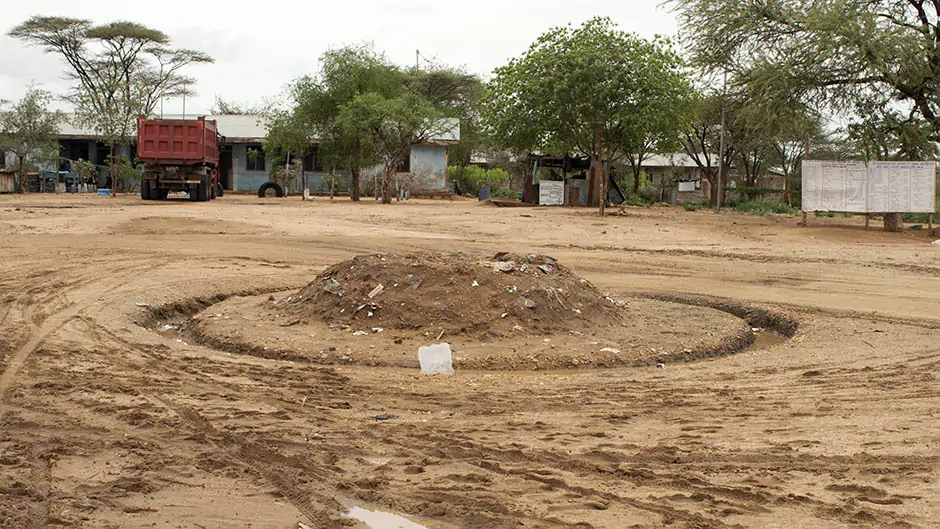
The town also represents a crossroads in a metaphorical sense. Since the loss of their traditional livelihood, some of the region's indigenous people (so far mainly Hamar) have been leaving their villages and migrating to the town. Other towns in the region are seeing the same trend. With this urbanization, there come the same social problems that accompany all migrations to a central hub. It is easy to see evidence of, for example, unemployment, urban poverty, drug abuse, alcoholism and prostitution.
A small number (mostly young men) come to the towns to pursue formal education. In some cases the village they left may have a school already. Another government program has begun to build schools in some of the villages in the region. Attendance at these schools is low and dropout rates are high. Multiple factors contribute to families rarely sending girls to school. For the boys, who are expected to learn Ethiopia's national curriculum, barriers to success are created by illiteracy, unfamiliarity with Amharic and the seasonal need for their labor.
Our destination the next day was the much larger town, Jinka. It is the gateway to indigenous Mursi villages, although I had already decided to stay in the town and come back to Arba Minch the following day. En route, we stopped to visit the market in Dimeka. This is one of the best towns to visit for a market experience. Most of the traders are Hamar and Karo, but other ethnicities to be found include Banna and Tsemay.
While it is a fascinating region in which to visit indigenous people, I did not particularly enjoy my few days in the Omo Valley. The main reason was that I am not comfortable witnessing people being treated like a human zoo or a living museum. This type of interaction is hardly what Carlo Conti Rossini had in mind when he called Ethiopia a "museum of peoples" almost a hundred years ago. I achieved my intended purpose of research/fact finding/location scouting for a potential, future and longer, more in-depth visit. In the end, however, I could no longer bring myself to be a participant in the zoo.
The recent history of the Omo Valley is a seminal case study of how not to manage economic development. Due to a plethora of such initiatives Ethiopia's debt is now around 60% of GDP — about half of it owed to China. Many of the projects have failed to yield the promised economic benefits and Ethiopia has been forced to restructure its debt payments. But most of the discussion is around political and economic theory. Far less attention is paid to the human cost. For example, in the case of the Gibe III dam, the impact assessment was undertaken only retrospectively, was riddled with conflict of interest and concluded that the impact to indigenous people would be negligible.
I took a public bus from Jinka back to Arba Minch. A third of the way into the journey the bus broke down. Despite the attempts of the driver and some of the passengers, nobody had the knowledge to repair it and we waited in searing heat for about three hours before a replacement bus arrived. That situation seemed representative of the broader situation in the region. The indigenous knowledge that might have contributed to real and sustainable economic development has also broken down and will, along with unique ancient human culture, eventually be lost forever.
Photography copyright © 1999 -
2025,
Ray Waddington. All rights reserved.
Text copyright © 1999 -
2025,
The Peoples of the World Foundation. All rights reserved.
Waddington, R., (2020) Loss of Indigenous Knowledge in the Omo Valley, Ethiopia. The Peoples of the World Foundation. Retrieved
December 8, 2025,
from The Peoples of the World Foundation.
<https://www.peoplesoftheworld.org/travelStory.jsp?travelStory=omo%20valley>
If you enjoyed reading this travel story, please consider buying us a coffee to help us cover the cost of hosting our web site. Please click on the link or scan the QR code. Thanks!



